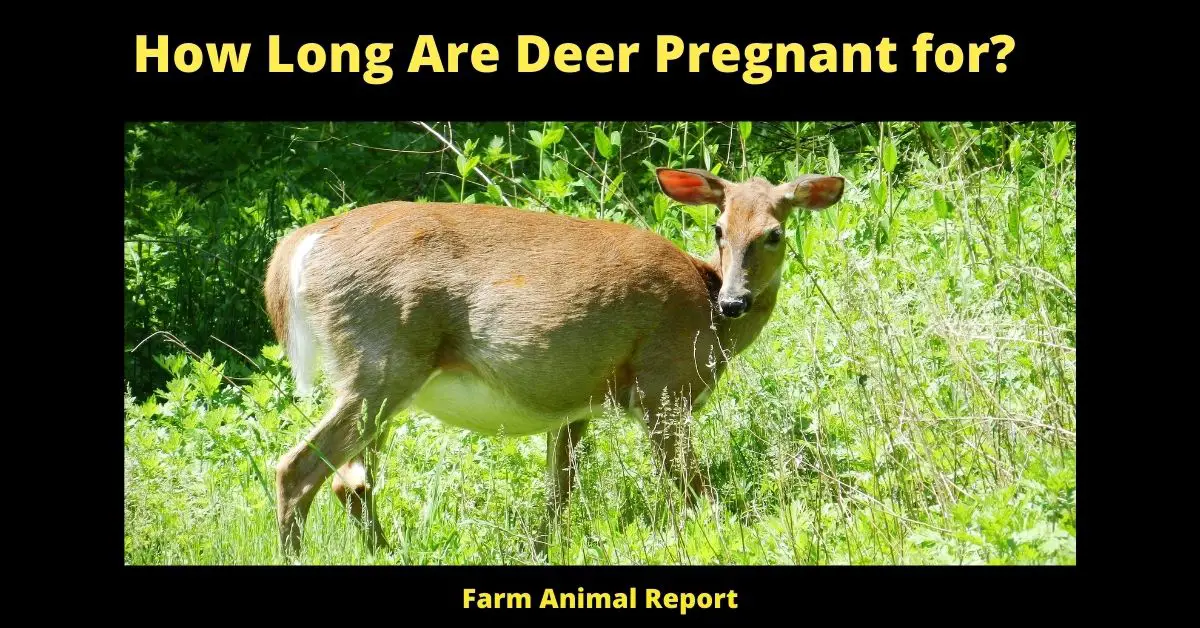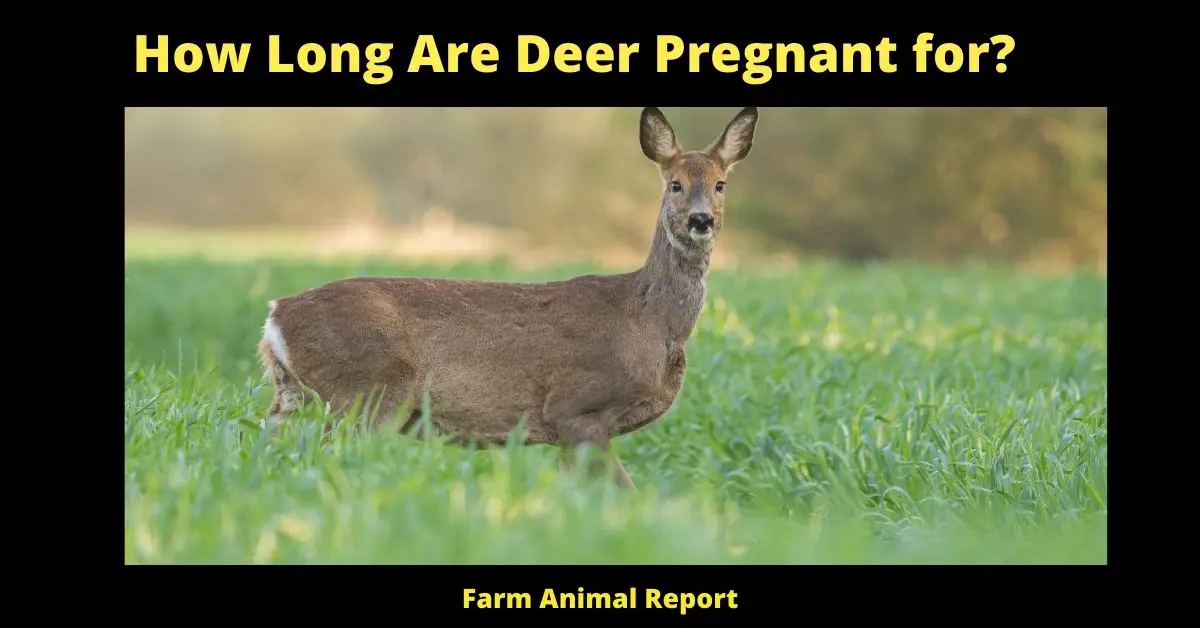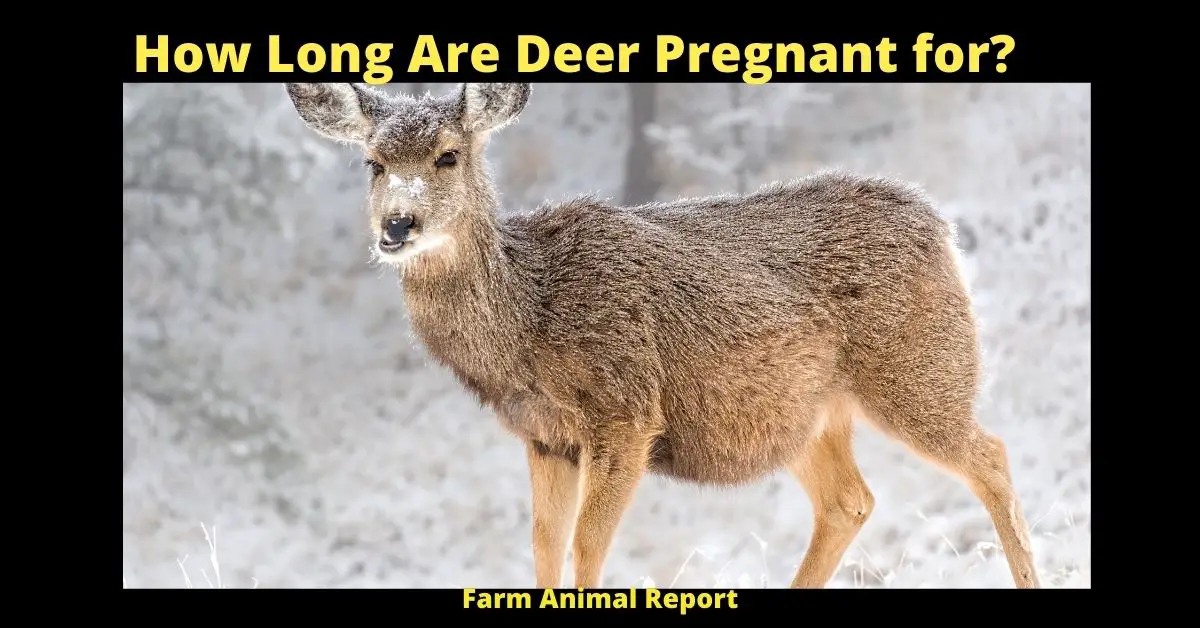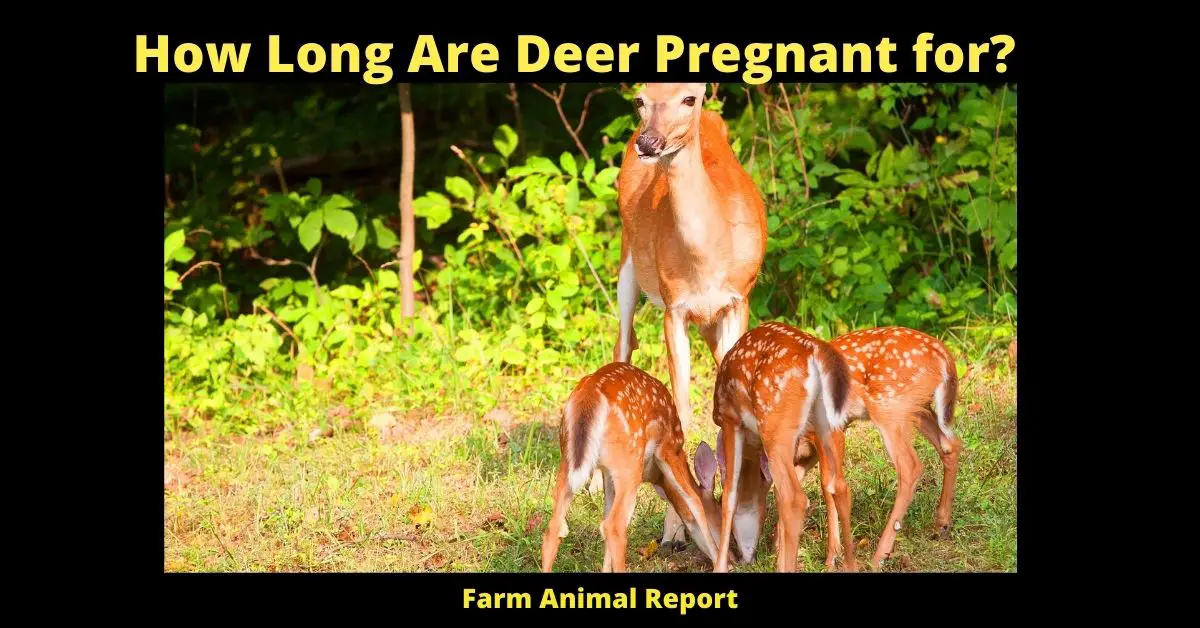Whitetail and Mule deer are pregnant (deer gestation) for 200 days or 6 1/2 months. Fawns are usually born in spring weighing approx 6lbs and being able to walk immediately after birth.
How Long Are Deer Pregnant for?
If you’re a hunter, or just interested in the deer population, you may have wondered about how long deer are pregnant. It’s a valid question – after all if you want to know when the best time to hunt them is, you need to know when they give birth! In this blog post, we will discuss deer reproduction and pregnancy timelines. Jump to How Long Are Deer Pregnant – ( FACTS & PHOTOS)
What are the Stages of Deer Pregnancy?
Check Out Amazons Educational Books on Whitetail Deer
When a deer is pregnant, it will have a gestation period of about 190 to 200 days and then give birth to one or two fawns. The gestation period for female deer can be anywhere from 170-235 days; the average being around 180 days. When they are ready to mate again after giving birth, they do so within just five months! This means that if you see an adult female without its young in early summer there’s a good chance she’ll soon have another baby on its way (or already has) because most females go into estrus six weeks after weaning their offspring – which would normally happen during late spring/early summer).

The stages of Deer Pregnancy Are:
- Fertilization
- When it comes time for a doe to mate with her buck, they’ll go through several rounds of intense courtship before she finally accepts him as being worthy enough (he’s gotta earn that right!). Once everything is said and done though; sperm cells swim up into the oviducts where they meet an egg cell waiting there just waiting to be fertilized.
- Fertilization occurs when one or more sperm cells fuse together their genetic material with those from inside the ovum by breaking down its outer coatings first so that it can penetrate deeper within this structure without encountering any resistance along the way. And then once all necessary components have been assembled, a new life begins!
- Implantation – After fertilization has taken place, the embryo will travel down through one of two fallopian tubes towards its eventual home in utero called a uterus. During this time some deer may experience spotting due to implantation bleeding which lasts up until around 12 days post-ovulation but not everyone is affected; so don’t worry if you do notice it happening! It’s completely normal and nothing at all serious should ever happen as long-term consequences have never been documented anywhere else on record either by accident or design.
- Embryonic Development – This is where everything starts to take shape! The embryo will grow and divide into more and more cells as it implants itself into the uterine lining around six days post-fertilization. It’ll continue to develop over the next few weeks (or months if born prematurely) until it becomes a fetus that’s ready for birth.
- Parturition – After spending anywhere from 190-200 days in utero, deer give birth to their young either head first or feet first depending on what position they were in during labor.
- Fawns weigh anywhere from four to eight pounds at birth and have spots all over their tiny little bodies which will eventually disappear as they grow older. Their mothers will lick them clean and then start nursing pretty much right away so that they can get the colostrum (first milk) which is important for providing them with all the nutrients they need to survive in those critical early stages of life.
- So there you have it! Everything you could ever want to know about deer pregnancy and then some. Just be sure to keep in mind that every doe experiences things a little differently than others so don’t take everything as gospel – if you’re ever unsure just ask someone who knows what they’re talking about and hopefully this article has helped point you in the right direction either way! How Long Are Deer Pregnant for?
What kind of care do Pregnant Deer Need during their Gestation Period?
Pregnant female deer are vulnerable to predators and must be very cautious in the wild. She will hide herself from other animals for two months before giving birth, making it impossible for a buck or human to find her newborn fawns that have not yet opened their eyes.
During this time period, she can sense danger by smell and hearing – so keep your distance! A mother does not want any stranger approaching her baby as they may confuse them with food or predators (which is why people should never feed young animals).
The best way to approach an adult female is slowly from behind while keeping quiet until you’re close enough that she doesn’t feel threatened anymore; then speak softly but firmly so there isn’t any confusion about whether there’s danger nearby.
The mother will not leave her newborn fawn until it can walk and run on its own, so if you see one alone then don’t worry too much – it was probably just left for something like eating some food or drinking water!
If you come across an adult female deer who is pregnant but does not want to be approached, try walking away slowly with your hands in front of yourself–this might make them feel less threatened as long as they know what direction the threat comes from (and that there won’t be any surprises).
You may also need to make noise before approaching a doe so she knows where you are coming from and isn’t startled when she smells you coming closer.
If there are any other signs of aggression such as raised hackles on their back or bared teeth, it’s best to leave them alone completely until they calm down before trying again; we don’t want her getting defensive if she has young nearby!

How will you know if a Deer has given Birth on your Property?
If a deer has given birth on your property, you may notice the following:
- There will be a fawn lying in your yard. If it is standing up, it is only because its mother has left to get more food. She will return shortly and take care of her baby again.
- You may see an adult female deer that seems listless or tired. This could mean she was just giving birth.
- The ground in the area where there are usually deer roaming around may look like it’s been dug up by something else; this indicates she had some trouble at first trying to give birth after all the work involved with getting pregnant and carrying the child for months beforehand.
If you see any of the above signs, it’s best to leave the fawn alone and give nature a chance to take its course. The mother will come back for her baby when she is ready, and there’s no need to worry – deer are very good mothers.
Fawns can typically stand within an hour of being born and walk within 12 hours; they are also capable of running shortly thereafter. So if you see one lying around your property but it’s not in any obvious danger, just let it be and keep an eye on things from a distance. If at any time you have concerns that the animal may be in danger or needs help, please contact local wildlife officials
What should you do if you find a Fawn Orphaned in the Wild?
If you find a fawn all alone, it’s not necessarily orphaned. In fact, even if the mother is nearby and did not immediately come to its rescue upon your approach, there is still a chance that she will return later in the day to nurse and care for her baby.
If you are able to stand at least 50 feet away from the fawn without being detected by other animals or humans (and thus avoid stressing out either human or animal), then this may be an opportunity for YOU to just observe nature as it unfolds before your very eyes!
The fact of the matter is: many people who think they have found an abandoned fawn end up witnessing its real mommy returning minutes later! Fawns can remain motionless and silent for hours at a time, which is their instinctual way of avoiding predators.
If the fawn is orphaned ( Mother killed, hunting, car accident, etc), you can call the local wildlife rehabilitation center for help. They are trained to handle and care for fawns without mother before they return to the wild once again!
Fawns can be bottle-fed if needed and will need to be released once they are eating solid food on their own.
A difficulty comes if the fawn or adolescent deer loses it fear of man, making them unsuitable for release back into the wild. This is often due to humans providing food, such as bread, apples, etc., or letting them come too close and petting them which causes deer to imprint on people instead of their natural fear of man. If this occurs rehabilitation centers have no choice but to keep these animals in captivity.
If you find an orphaned fawn:
- Call your local wildlife rehabilitator for assistance
- The fawn may be bottle-fed if necessary
- Fawns will need to be released once they are eating solid food on their own
- Do not keep a fawn as a pet. It is illegal to take wildlife from the wild without a license (even if the intent is to nurse it back to health and release it)
- Call your local DNR or Game Warden for more information about local laws regarding possession, distribution, transport and rehabilitation of exotic species in your area
- If you find an injured adult deer: Call your nearest licensed rehabilitator and/or State game management agency for assistance If you cannot reach them immediately: -Securely confine the animal in a dead end compartment of some sort so that there are no escape routes if possible. This will help prevent further injury while awaiting rescue (deer can be dangerous when cornered or injured)
- Do not attempt to handle the animal. Deer are large animals with sharp hooves and antlers that can cause serious injury even when they’re well-meaning humans think they’re being helpful by helping them up off their side or back (a common mistake).
- If you are able to safely confine an uninjured deer until help arrives, do so! This will prevent any further injuries from occurring while waiting for rescue services such as those provided by wildlife rehabilitators and veterinary clinics specializing in exotic medicine

Final Thoughts -How Long Are Deer Pregnant for?
In Conclusion, Whitetail and Mule deer gestation is around 210 days. Fawns can nurse for up to 12 months but will start to graze on their own at around six months old. If you find an orphaned deer, please call your local wildlife rehabilitation center for assistance.
They are trained to handle and care for fawns without mother before they return to the wild once again! If you find an injured adult deer, please call your nearest licensed rehabilitator and/or State game management agency for assistance.
Remember: it is illegal to possess a wild animal without proper permits in most cases! For more information about local laws regarding possession, distribution, transport, and rehabilitation of exotic species in your area contact your DNR or Game Warden.


